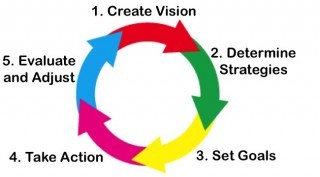One of the biggest mistakes leaders make is moving from vision to execution as though it’s a linear process. The widely held assumption is they are two ends of a spectrum: Vision is about planning. Execution is about action.
The truth is: Vision requires action to be clarified and refined, and execution requires reflection to be effective.
IT’S NOT LINEAR
Most leadership experts subscribe to some variation of these five steps.
 The model is logical. But in reality, most of us don’t live our lives that way, and most leaders are not rigorous about it, because life doesn’t wait while you are planning. No wonder so many leaders have little patience with the first steps.
The model is logical. But in reality, most of us don’t live our lives that way, and most leaders are not rigorous about it, because life doesn’t wait while you are planning. No wonder so many leaders have little patience with the first steps.
CIRCULAR IS BETTER
When you think of these steps as circular, it gives a better sense of their ongoing repeating nature.
A reality check will verify that all of these steps are important. Anyone who has worked with a leader who acts randomly (“ready-fire-aim”) knows what a mess they leave behind. And leaders who avoid taking action can be just as frustrating.
But this approach is still sequential and doesn’t match up with the reality of our messy lives and organizations. It’s simply not accurate to represent a dynamic, interrelated process as a series of sequential steps.
TRY SPINNING THE CIRCLES
Try thinking of the circle as dynamic – spinning so fast that the colors turn white. You can’t see the individual parts, even though you know they’re there.
 While working on one step, you pay attention to how that step impacts all the other steps. Which steps you need to focus on at any point are determined by feedback from your environment and your own experience, instead of a chart.
While working on one step, you pay attention to how that step impacts all the other steps. Which steps you need to focus on at any point are determined by feedback from your environment and your own experience, instead of a chart.
This is a way of working and doing business, not simply a way to approach projects. And since it is ongoing, “evaluate and adjust” is no longer a step. It becomes integrated into daily life and the way you approach work.
By acknowledging reality is far from linear and assuming a dynamic approach, you are freed to work on the right steps at the right time. And both your vision and execution will become smarter, easier, faster, and smoother.
3 GUIDELINES FOR A DYNAMIC APPROACH
Do vision and execution simultaneously.
Don’t separate vision and execution as though they are two different things. As you develop your vision, no matter what stage your vision is in, continually align your actions with it. And don’t set your vision aside once you’ve moved to another step.
You don’t have to wait for your vision to be “finished” before you start. Build it as you envision it. Learn and adjust as you go.
Think of your vision as unbaked clay.
Allow your vision to be reshaped based on new information, feedback, what you have learned and changes in your environment. Don’t assume that you “own” the vision. Allow others to influence its shape – to put their thumbprints on it.
As you move closer to your vision, you will understand it more deeply. It might look like it has changed on the outside, but the essence will remain the same.
Be fluid.
When working on any of these steps, give it your full attention and strive for excellence, but always consider the big picture and how what you are doing affects the other steps. Be ready to move fluidly among the steps as it makes sense.
Although these are described as distinct steps, in reality they are not separate. This is simply a model to help you organize your thinking, and it not reality.














Jesse, this makes so much sense. Thanks for brining clarity to the process. I love the spinning wheel concept.
Thanks Dan. Glad you found it helpful. It seems to me our models need to be dynamic to reflect reality, yet simple to help us navigate the complexity. Thanks for stopping by. Always great to see you here.
Jesse,
A really clear message here. One that I resonate with in terms of “doing” vision and execution simultaneously. So well worded when you write it! It would have been well worth reading even *before* you included the section on the dynamic approach.
Thanks so much, Jake. It means a lot coming from someone whose work I so greatly respect.
“Dynamic and reflective of reality”. So true. It makes me stop in my tracks and question if my execution and vision are moving together, intersecting like strands of DNA. As always, you explain things: faster, smoother, easier. Brilliant, Jesse.
That’s a great analogy, Eileen – intersecting like strands of DNA. Thanks for that!
Jesse – This is awesome! It makes so much more sense to my brain to visualize this as an active process, not an event. (What a brilliant way to help people understand that you don’t just write the statement and hang it on the wall and let it colect dust!)
My cells are dancing as I visualize how much I relate to this! Thank you!
So glad this works for you, Chery. Love the idea of your cells dancing!
Love it Jesse!
Quite awhile back on one of your others posts, I think it was one of yours anway! : ) … I mentioned nursing notes. Athough there are different formulas for writing up our notes and assessments on patients in the health care setting (i.e SOAP, SOAPIER, POP charting etc) they all contain the basic formula that includes our observations of objective and subjective data, nurse diagnosis (different than a doctors diagnosis), creating a plan implementing the plan, and than revising the plan as needed.
So it’s an ongoing evolution that changes as needed based on the changes and healing of the patient (client).
And similar to your post here, it’s a circular or spiral rather than linear. It’s all dependent on the changes that come up which require ongoing monitoring, evaluations, and developing new plants to accommodate these changes. Including a bit of triage from the beginning of the process. Order of priorities address the most serous and critical needs, etc.
One thing I can say when it comes to action or lack thereof…in both business AND in our personal lives. If we have put off action, eventually any business or individual will be FORCED to act at some point. Simply when a need or needs become too critial to overlook and can’t be ignored anymore. i.e When the pain gets bad enough, we go see the dentist or the doctor. When the money runs out, we are forced to do something different. When a business is stuck in the red, it is forced to change or go out of business, etc.
Thanks for another great post.
Hi Samantha, Thanks for sharing the nursing approach to planning for care. Sounds like a connected process. And thanks also for your thoughts on taking action. I agree, at some point you will move… and the question is whether it is with intention and consciousness or in reactivity.
Hi Jesse
You are very right they are nothing close to linear, in fact they are a lot like a stew, in every mouthful (everyday) you end up with a different combination of ingredients (on different days you will have to spend different amounts of time adapting or analyzing each phase). The collection of spinning discs is rather good as well. I often find that each time I evaluate, I have impacts on vision, strategy and goals. And Every time I adjust anyone of them I have to adjust the others accordingly, which all end up affecting required action, and we are back again at evaluation, it never ends and is always connected together.
The models may seem like chaos, but as recent studies prove chaos often deliveries better results, excess control does one thing well it delivers mediocrity.
Love the stew analogy! Yes, the challenge is not to deny the chaos but to learn to navigate within it. Models help us organize our thinking and make sense out of the chaos. But I’ve always had trouble with linear models because life is not a one-way street. Developmental models call it “regression” when you go backwards, but that sounds pejorative. I think life just bounces us around at times and we need to look around to see where we landed.